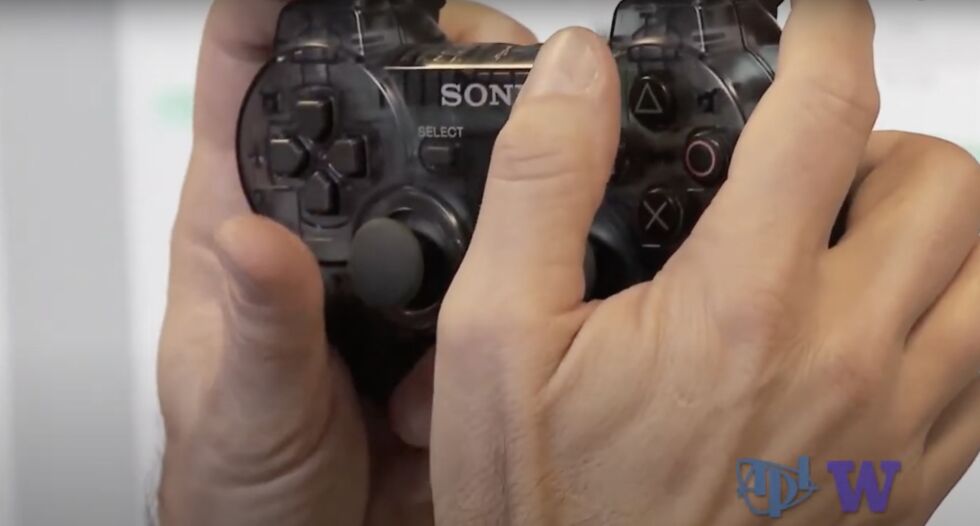

CBS Sunday Morning
In a 2022 CBS Sunday Morning segment, CEO Stockton Rush of deep-water submersible company OceanGate gave journalist David Pogue a fun reveal. “We run the whole thing with this game controller,” Rush said, holding up a Logitech F710 controller with 3D-printed thumbstick extensions. The controller was wireless, and it was the primary method for controlling the Titan submersible, which would soon make a visit to the wreck of the Titanic. Pogue laughed. “Come on!” he said, covering his eyes with his hand.
Journalists loved the controller story, covering the inexpensive F710 and the ways that video game controllers have become common control solutions in various military and spaceflight applications in recent years. After all, if your engineers and pilots grew up using two-stick controllers to waste their friends in Halo multiplayer, why not use that built-in muscle memory for other purposes?
So the use of a video game controller was not in itself a crazy decision. But after the Titan sub imploded on a June 2023 dive to the Titanic site, killing all five passengers including Stockton Rush, the use of a wireless $30 control interface began to look less “cool!” and more “isn’t that kind of risky?” The only question at that point was how long it would take the Logitech F710 to show up in a lawsuit.
This week, we got our answer. In the first Titan wrongful death lawsuit, filed this week by the estate of Paul-Henri Louis Emile Nargeolet, the Logitech controller comes in for some prominent criticism.
“Hip, contemporary, wireless”
Nargeolet “was known worldwide as ‘Mr. Titanic,'” says the new lawsuit (PDF) against OceanGate, Rush’s estate, and various companies that helped build the Titan. Nargeolet had been on 37 dives to the Titanic wreckage and, on his final dive, was working with OceanGate as a Titan crewmember who would “guide other crewmembers and assist with navigation through the Titanic wreckage, which he knew so well.”
The lawsuit reiterates all the main criticisms of the Titan.
First, the sub was not made from titanium (as most submersibles are), which gets stronger under compression; it was made instead from carbon fiber, which can crack under repeated compression. Rush, who saw himself as an innovator like “Steve Jobs or Elon Musk,” the complaint says, once told Pogue, “At some point, safety just is pure waste.” Rush thought he had found a lighter way to build subs.
Second, the complaint singles out the Titan’s “hip, contemporary, wireless electronics systems.” (Those adjectives are not compliments).
TITAN was piloted using a mass-produced Logitech video game controller (normally used with a PlayStation or Xbox) rather than a controller custom-made for TITAN’s design and operation. Moreover, the controller worked via Bluetooth, rather than being hardwired. TITAN also had only “one button” (for power) within its main chamber—the remainder of its controls (for lights, ballast and so on) and gauges (for depth, oxygen level and so forth) were touchscreen. RUSH stated that TITAN was “to other submersibles what the iPhone was to the BlackBerry.” As with an iPhone, however, none of the controller, controls or gauges would work without a constant source of power and a wireless signal.
OceanGate’s previous submersible, the Cyclops I, had also used a video game controller (a Sony DualShock 3) and some other wireless tech.

The complaint quotes an expert saying that such systems provided “multiple points of failure” and that “‘every sub in the world has hardwired controls for a reason,’ namely that a loss of signal would not imperil the vessel.” But such issues were “disregarded by OceanGate, as Titan employed nearly identical systems to Cyclops I,” says the complaint.
The lawsuit also attacks the engineering team that designed and integrated all the electronics systems into Titan, saying that the team was made up mostly of current or recent Washington State University grads with “virtually no real-world experience and no prior exposure to the deep-sea diving industry.”
The complaint does not allege that the Logitech wireless controller, the carbon fiber construction, Titan’s innovative porthole, or the use of disparate materials with differing expansion/compression coefficients—four main areas of criticism—were individually responsible for the sub’s implosion. But it does suggest that these systems could have together contributed to a “daisy chain of failures of multiple improperly designed or constructed parts or systems.” The complaint says that Nargeolet’s estate is entitled to at least $50 million in damages.
Too good to be true
A final investigatory report from various government agencies has been in process for over a year and has not yet been completed, but it seems likely that the Logitech controller—along with the five people on the sub—is gone forever.
But the prospect of a cheap piece of plastic surviving the catastrophic implosion was just too good for social media to ignore. Shortly after the Titan disaster, people began “sharing a photo that purports to show the controller resting on the bottom of the sea,” according to a 2023 AP fact check. “The image shows a sandy ocean bottom with a part of the photo magnified to supposedly show a close up of the controller.”
“The cheapest part survived,” one X (Twitter) user posted.
Alas, it did not; the photo was a fake.